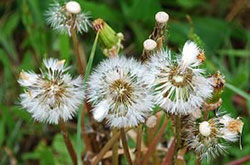Adapted from the CO-Horts blog originally authored by Jane Rozum, Douglas County.

Dandelion seeds |
Weeds can be a troublesome nuisance in gardens and landscapes. Many gardeners are surprised how many weeds can pop up from year to year. How do they get into our landscapes? Weed seeds can blow in, wash in with surface water, or be introduced with the application of soils and organic matter, like manure and compost. Birds and other wildlife also distribute weed seeds. However, the majority of weeds come from seed unsuspectingly planted by the gardener. In other words, weeds allowed to go to seed will plant themselves in our gardens. This ‘weed seed bank’ may reseed a garden or landscape for years to come.
Many common species of weeds can produce thousands of seeds in a season, from one plant. Over the course of one year, a dandelion can produce 15,000 seeds, purslane, 52,300, pigweed, 117,400 and mullein can produce over 220,000 seeds. The viability of a seed, that is, the how long a seed is able to persist in the soil is also a factor. Dandelion seed does not have long-term viability in the soil, but purslane and pigweed seeds may persist in soil for 20 and 40 years, respectively. Mullein seeds may persist in the soil for up to 100 years. This demonstrates that the weed seed bank can produce weeds in gardens and landscapes for many years to come.
To decrease the possibility of a weed seed bank developing in gardens and landscapes:
- The best weed control is applied when the weed is young. Mechanical control is easier when weeds are young, and herbicides work best at this stage as well. There are pre-emergent products that kill weed seeds before they germinate.
- Keep your garden and lawn healthy to promote weed growth competition. Deep, infrequent watering schedule works well for lawns and gardens, but shallow-rooted weeds don’t do well with this type of watering routine. Healthy lawn and garden plants will crowd out and compete with weeds for light and nutrients, so keep nurturing your landscape throughout the gardening season.
- Apply mulch in garden and landscape areas. CSU Extension recommends 3-4 inches of weed-free mulch so weed seeds can’t germinate. Landscape fabric under the mulch is not necessary and can contribute to lower garden plant vigor.
Most important of all: Do not let weeds contribute to the seed bank in your landscape. If weeds do pop up in your garden, pull or cut off the flower head. The weed may still grow and attempt to flower again, but if weeds never set seed, it cannot contribute to the weed seed bank.
For more information, see the following Colorado State University Extension fact sheet(s).
For more information, see the following Planttalk Colorado™ script(s).



